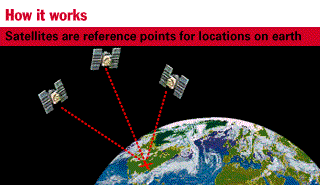 By using an extra satellite range measurement and
a little algebra a GPS receiver can eliminate any clock inaccuracies it might have.
Rather than fooling with algebra let's examine the principle with some drawings. These
drawings will be a lot easier to understand if we keep them two-dimensional.
Of course, GPS is a 3-dimensional system but the principles will work just fine in two
dimensions. Just remember that in the real 3-dimensional system we need to add one more
measurement.
Also we've been talking about satellite ranges in terms of distance but since these
ranges are just calculated from time let's simplify things by talking about ranges as
times.
OK, the object here is to see how an extra satellite range can be used to determine if
our receivers clocks are out of sync with universal time.
Let's say that in reality our position is four seconds from satellite A and six seconds
from satellite B. Those two ranges cross and the intersection is our position (remember
we're only working in 2D).
Continue |